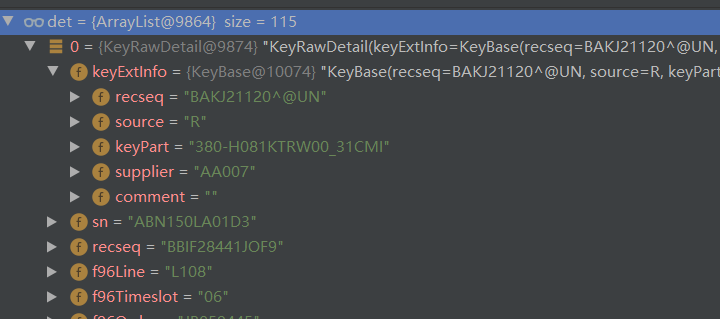有一个数据集输出如下,a表与b表关联,a表主键recseq,其他字段为f96_*,b表主键b_recseq,其他字段为source/keyPart/supplier/comment/sn

由于source/keyPart/supplier/comment是通用字段,其他地方也会复用,所有将这4个字段抽离,entity如下:
@Data
@NoArgsConstructor
public class KeyBase {
private String recseq;
private String source;
private String keyPart;
private String supplier;
private String comment;
}
对应的resultmap:
<resultMap id="KeyBaseMap" type="com.xx.yy.KeyBase">
<id column="b_recseq" jdbcType="VARCHAR" property="recseq" />
<result column="source" jdbcType="VARCHAR" property="source" />
<result column="keyPart" jdbcType="VARCHAR" property="keyPart" />
<result column="supplier" jdbcType="VARCHAR" property="supplier" />
<result column="comment" jdbcType="VARCHAR" property="comment" />
</resultMap>
那么整个数据集的entity定义如下,它继承于T96PdLog又有KeyBase信息,也多了个sn字段:
@NoArgsConstructor
@Data
public class KeyRawDetail extends T96PdLog {
private KeyBase keyExtInfo;
private String sn;
}
对应的resultmap应该定义成如下:
<resultMap id="RawDataMap" type="com.xx.yy.entity.KeyRawDetail"
extends="com.xx.yy.dao.T96PdLogMapper.BaseResultMap">
<result column="sn" jdbcType="VARCHAR" property="sn" />
<association property="keyExtInfo"
column="recseq"
resultMap="KeyBaseMap"
/>
</resultMap>
补充说明一下,association 应用比较灵活,这里的意思是,通过A表的主键recseq(column指定)去关联B表的b_recseq(看KeyBaseMap的id定义),然后mybatis会根据KeyBaseMap里面的结果集定义自动将数据集中的source/keyPart/supplier/comment组装成keyExtInfo的字段。
最后,select的定义:
<select id="getRawData" resultMap="RawDataMap">
select * from rawdata order by f96_mgtbarcd;
</select>
结果如下:

最后
以上就是复杂心情最近收集整理的关于Mybatis的resultmap的继承、关联的全部内容,更多相关Mybatis内容请搜索靠谱客的其他文章。
本图文内容来源于网友提供,作为学习参考使用,或来自网络收集整理,版权属于原作者所有。
![[Windows Azure] .NET Multi-Tier Application Using Storage Tables, Queues, and Blobs - 1 of 5.NET Multi-Tier Application Using Storage Tables, Queues, and Blobs - 1 of 5](https://file2.kaopuke.com:8081/files_image/reation/bcimg12.png)

![[Windows Azure] Windows Azure Virtual Network OverviewWindows Azure Virtual Network Overview](https://file2.kaopuke.com:8081/files_image/reation/bcimg14.png)





发表评论 取消回复